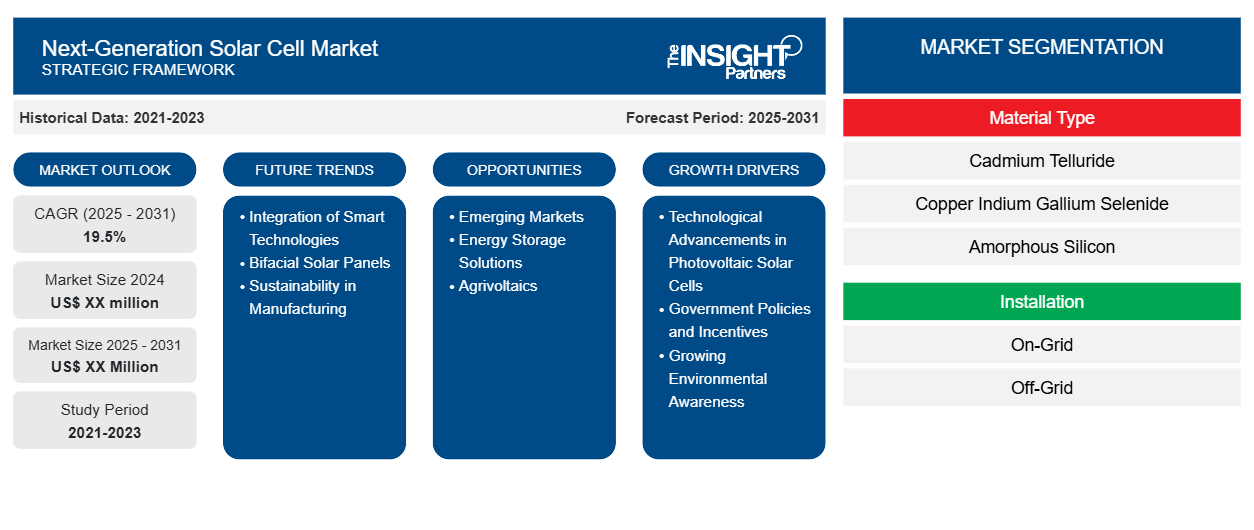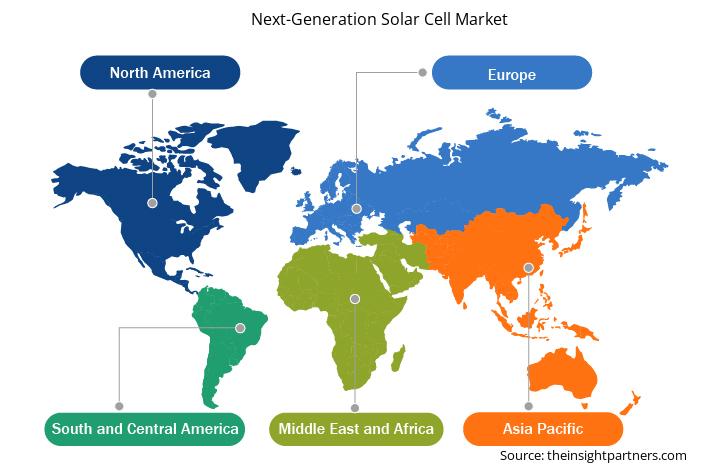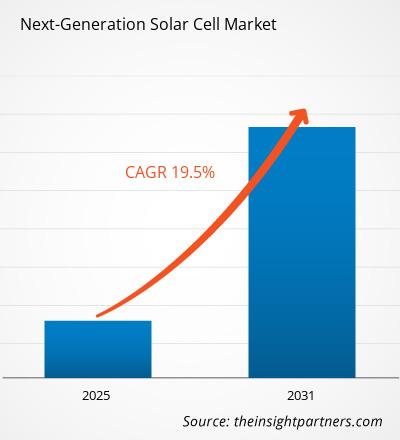بلغت قيمة سوق الخلايا الشمسية من الجيل التالي العالمية 4.13 مليار دولار أمريكي في عام 2024، ومن المتوقع أن تصل إلى 12.95 مليار دولار أمريكي بحلول عام 2031. ومن المتوقع أن يسجل سوق الخلايا الشمسية من الجيل التالي معدل نمو سنوي مركب بنسبة 15.73% من عام 2025 إلى عام 2031. ومن المرجح أن تظل الاستدامة والتصنيع الأخضر اتجاهًا رئيسيًا في السوق.
تحليل سوق الخلايا الشمسية من الجيل التالي
يشهد سوق الخلايا الشمسية من الجيل التالي زخمًا متزايدًا، مدفوعًا بالتوجه العالمي نحو الطاقة النظيفة، والابتكار في تكنولوجيا الخلايا الكهروضوئية، وتطور أنماط استهلاك الطاقة. ومن أهم محركات السوق الطلب المتزايد على حلول الطاقة الشمسية عالية الكفاءة ومنخفضة التكلفة. توفر تقنيات الجيل التالي - مثل البيروفسكايت، والخلايا الكهروضوئية العضوية (OPV)، والخلايا الشمسية الترادفية - معدلات تحويل طاقة مُحسّنة، ومرونة، وتصميمات خفيفة الوزن، مما يجعلها جذابة لمجموعة واسعة من التطبيقات، بدءًا من الخلايا الكهروضوئية المدمجة في المباني ووصولًا إلى الأجهزة الإلكترونية المحمولة. يدفع تزايد المخاوف البيئية والتزامات تحقيق صافي انبعاثات صفري الحكومات والشركات إلى الاستثمار في تقنيات الطاقة المتجددة المتقدمة. وتُسرّع الحوافز والإعانات وتمويل البحث والتطوير في مناطق مثل أوروبا وأمريكا الشمالية وآسيا والمحيط الهادئ من تسويق تقنيات الطاقة الشمسية الناشئة.
نظرة عامة على سوق الخلايا الشمسية من الجيل التالي
تُمثل الخلايا الشمسية من الجيل التالي تطورًا في تكنولوجيا الطاقة الكهروضوئية، حيث تُقدم كفاءة أعلى وتكاليف تصنيع أقل وتنوعًا أكبر مقارنةً بالألواح الشمسية التقليدية القائمة على السيليكون. تشمل هذه الخلايا الشمسية المتقدمة تقنيات مثل البيروفسكايت، والخلايا الكهروضوئية العضوية (OPV)، والنقاط الكمومية، والخلايا متعددة الوصلات، والخلايا ذات الأغشية الرقيقة. صُممت هذه الخلايا للتغلب على قيود الأنظمة التقليدية من خلال تقديم أداء فائق في ظروف إضاءة متنوعة، وعوامل شكل خفيفة الوزن ومرنة، وإمكانية دمجها في مجموعة واسعة من الأسطح والمنتجات. بالإضافة إلى ذلك، فإن إمكانية انخفاض تكاليف الإنتاج وسهولة التوسع تجعل هذه التقنيات جذابة للنشر على نطاق واسع. تستثمر الشركات بشكل متزايد في البحث والتطوير، وتُشكل شراكات استراتيجية لتسويق حلول الطاقة الشمسية من الجيل التالي، مدعومة بسياسات حكومية داعمة والتزامات الاستدامة. مع تحول الاقتصاد العالمي نحو طاقة أنظف وأهداف محايدة الكربون، تُعتبر الخلايا الشمسية من الجيل التالي أصلًا استراتيجيًا يُمكّن الشركات من الابتكار، وخفض تكاليف الطاقة، والتوافق مع الالتزامات البيئية طويلة الأجل.
ستحصل على تخصيص لأي تقرير - مجانًا - بما في ذلك أجزاء من هذا التقرير، أو تحليل على مستوى الدولة، وحزمة بيانات Excel، بالإضافة إلى الاستفادة من العروض والخصومات الرائعة للشركات الناشئة والجامعات
سوق الخلايا الشمسية من الجيل القادم: رؤى استراتيجية

- احصل على أهم اتجاهات السوق الرئيسية من هذا التقرير.ستتضمن هذه العينة المجانية تحليل البيانات، بدءًا من اتجاهات السوق وحتى التقديرات والتوقعات.
محركات وفرص سوق الخلايا الشمسية من الجيل التالي
الحاجة المتزايدة إلى حلول خفيفة الوزن ومرنة لصالح السوق
يتزايد الطلب على تقنيات الطاقة الشمسية خفيفة الوزن والمرنة بسرعة، حيث تتطلع الصناعات إلى دمج الطاقة المتجددة في التطبيقات غير التقليدية والمتنقلة ومحدودة المساحة. تتميز الألواح الشمسية التقليدية القائمة على السيليكون بصلابتها وثقتها وصغر حجمها، مما يحد من استخدامها في قطاعات مثل الفضاء والسيارات والإلكترونيات الاستهلاكية والبناء. أما الخلايا الشمسية من الجيل التالي، وخاصةً الأغشية الرقيقة والخلايا الكهروضوئية العضوية (OPVs) والخلايا القائمة على البيروفسكايت، فتتميز بمزايا كبيرة. ويمكن تصنيع هذه التقنيات على ركائز خفيفة الوزن ومرنة، مثل البلاستيك والزجاج والرقائق المعدنية، مما يجعلها مثالية للأسطح المنحنية أو المتحركة. فعلى سبيل المثال، يُعد الوزن عاملاً حاسماً في تكنولوجيا الفضاء والطائرات بدون طيار. وتساعد الأغشية الشمسية فائقة الخفة على إطالة مدة الطيران وتوفير الطاقة للأنظمة على متن الطائرة دون زيادة كبيرة في الكتلة. وفي قطاع السيارات، يتم دمج الألواح الشمسية المرنة في أسطح ونوافذ المركبات لشحن البطاريات وتشغيل أنظمة السيارة، مما يدعم التوجه المتزايد نحو المركبات الكهربائية الموفرة للطاقة. وعلى نحو مماثل، في مجال الإلكترونيات الاستهلاكية، تمكن المواد الشمسية المرنة من إنشاء الأجهزة القابلة للارتداء وأجهزة الاستشعار والأجهزة المحمولة القادرة على حصاد الطاقة.
ارتفاع الطلب العالمي على الطاقة والكهرباء
يتسارع التحول العالمي نحو الكهرباء بوتيرة سريعة، مدفوعًا بالاعتماد الواسع النطاق على المركبات الكهربائية (EVs) والمنازل الذكية والأتمتة الصناعية وتوسع البنية التحتية الحضرية. يخلق هذا التحول طلبًا غير مسبوق على مصادر كهرباء نظيفة وموثوقة ولامركزية. إن أنظمة الطاقة التقليدية، التي غالبًا ما تعتمد على الوقود الأحفوري والشبكات المركزية، أصبحت غير كافية بشكل متزايد لتلبية احتياجات الطاقة الديناميكية والموزعة للاقتصادات الحديثة. تبرز تقنيات الطاقة الشمسية من الجيل التالي كحل حيوي لهذا التحدي. على عكس الألواح التقليدية، توفر الخلايا الشمسية المتقدمة - مثل البيروفسكايت والخلايا الكهروضوئية العضوية (OPVs) والخلايا الترادفية - كفاءة أعلى وتكاملًا مرنًا وقابلية للتوسع، مما يجعلها مثالية لحالات الاستخدام المتنوعة. يمكن نشرها عبر أسطح المنازل والمركبات والبنية التحتية والأجهزة المحمولة، مما يدعم نموذج طاقة لامركزي يقلل من الاعتماد على الشبكة وخسائر النقل.
تقرير تحليل تجزئة سوق الخلايا الشمسية من الجيل التالي
القطاعات الرئيسية التي ساهمت في اشتقاق تحليل سوق الخلايا الشمسية من الجيل التالي هي نوع المادة ونوع التثبيت والمستخدم النهائي
- بناءً على نوع المادة، يتم تقسيم السوق إلى تيلورايد الكادميوم (Cdte)، وسيلينيد الغاليوم الهندي النحاسي (CIGS)، والبيروفسكايت، والمواد النانوية، وغيرها.
- على أساس نوع التثبيت، يتم تقسيم السوق إلى داخل الشبكة وخارج الشبكة.
- بناءً على المستخدم النهائي، يتم تقسيم السوق إلى سكني وتجاري وصناعي.
تحليل حصة سوق الخلايا الشمسية من الجيل التالي حسب المنطقة الجغرافية
ينقسم النطاق الجغرافي لتقرير سوق الخلايا الشمسية من الجيل التالي بشكل أساسي إلى خمس مناطق: أمريكا الشمالية وأوروبا ومنطقة آسيا والمحيط الهادئ والشرق الأوسط وأفريقيا وأمريكا الجنوبية والوسطى.
هيمنت منطقة آسيا والمحيط الهادئ على السوق في عام 2024. وتبرز منطقة آسيا والمحيط الهادئ كمركز نمو رئيسي لسوق الخلايا الشمسية من الجيل التالي، مدفوعةً بدعم سياساتي قوي، وتسارع وتيرة التصنيع، وتزايد الطلب على الطاقة في المنطقة. وتستثمر حكومات دول مثل الصين والهند واليابان وكوريا الجنوبية وأستراليا بنشاط في البنية التحتية للطاقة المتجددة لتقليل الاعتماد على الوقود الأحفوري وتحقيق أهداف صارمة لإزالة الكربون. وتتصدر الصين، على وجه الخصوص، قطاع تصنيع الطاقة الشمسية العالمي، وتستثمر بكثافة في تقنيات الطاقة الشمسية المتقدمة مثل البيروفسكايت والخلايا الترادفية للحفاظ على هيمنتها على السوق. كما تعمل الهند على توسيع قدرتها الإنتاجية من الطاقة الشمسية بوتيرة سريعة، مما يخلق فرصًا لخلايا الجيل التالي عالية الكفاءة ومنخفضة التكلفة، والتي تناسب احتياجات مناخها وشبكتها. وفي الوقت نفسه، تستفيد اليابان وكوريا الجنوبية من الابتكار في تقنيات الطاقة الشمسية العضوية والأغشية الرقيقة لدعم احتياجات الطاقة المحلية والنمو القائم على التصدير. ويؤدي التوسع الحضري، وزيادة الاعتماد على الكهرباء، والسعي لتوفير الطاقة في المناطق الريفية والنائية إلى زيادة الطلب على حلول الطاقة الشمسية خفيفة الوزن والمرنة واللامركزية. تُعدّ خلايا الجيل التالي مثاليةً لهذه التطبيقات، بما في ذلك أنظمة الأسطح، والأجهزة المحمولة، والخلايا الكهروضوئية المدمجة في المباني (BIPV). إضافةً إلى ذلك، تُشكّل صناعتا الإلكترونيات والسيارات القويتان في المنطقة تآزرًا طبيعيًا مع تقنيات الطاقة الشمسية المتقدمة، لا سيما فيما يتعلق بدمجها في السيارات الكهربائية والأجهزة الاستهلاكية. تُرسّخ هذه العوامل مجتمعةً مكانة منطقة آسيا والمحيط الهادئ كمحرك رئيسي للابتكار والتبني في سوق الخلايا الشمسية من الجيل التالي.
رؤى إقليمية حول سوق الخلايا الشمسية من الجيل التالي
قام محللو شركة The Insight Partners بشرح شامل للاتجاهات والعوامل الإقليمية المؤثرة في سوق الخلايا الشمسية من الجيل التالي خلال فترة التوقعات. كما يناقش هذا القسم قطاعات سوق الخلايا الشمسية من الجيل التالي ومناطقها الجغرافية في أمريكا الشمالية، وأوروبا، وآسيا والمحيط الهادئ، والشرق الأوسط وأفريقيا، وأمريكا الجنوبية والوسطى.

- احصل على البيانات الإقليمية المحددة لسوق الخلايا الشمسية من الجيل التالي
نطاق تقرير سوق الخلايا الشمسية من الجيل التالي
| سمة التقرير | تفاصيل |
|---|---|
| حجم السوق في عام 2024 | 4.13 مليار دولار أمريكي |
| حجم السوق بحلول عام 2031 | 12.95 مليار دولار أمريكي |
| معدل النمو السنوي المركب العالمي (2025 - 2031) | 15.73% |
| البيانات التاريخية | 2021-2023 |
| فترة التنبؤ | 2025-2031 |
| القطاعات المغطاة | حسب نوع المادة
|
| المناطق والبلدان المغطاة | أمريكا الشمالية
|
| قادة السوق وملفات تعريف الشركات الرئيسية |
|
كثافة اللاعبين في سوق الخلايا الشمسية من الجيل التالي: فهم تأثيرها على ديناميكيات الأعمال
يشهد سوق الخلايا الشمسية من الجيل التالي نموًا سريعًا، مدفوعًا بتزايد طلب المستخدمين النهائيين نتيجةً لعوامل مثل تطور تفضيلات المستهلكين، والتقدم التكنولوجي، وزيادة الوعي بفوائد المنتج. ومع تزايد الطلب، تعمل الشركات على توسيع عروضها، والابتكار لتلبية احتياجات المستهلكين، والاستفادة من الاتجاهات الناشئة، مما يعزز نمو السوق.
تشير كثافة اللاعبين في السوق إلى توزيع الشركات العاملة في سوق أو قطاع معين. وتشير إلى عدد المنافسين (اللاعبين في السوق) المتواجدين في سوق معين نسبةً إلى حجمه أو قيمته السوقية الإجمالية.
الشركات الرئيسية العاملة في سوق الخلايا الشمسية من الجيل التالي هي:
- خلايا هانوا كيو
- أكسفورد للطاقة الكهروضوئية
- كانيكا للطاقة الشمسية
- فليسوم
- مجموعة ميتسوبيشي للكيماويات
- مجموعة طاقة الأغشية الرقيقة هانيرجي$هيلياتيك
إخلاء المسؤولية : الشركات المذكورة أعلاه ليست مرتبة بأي ترتيب معين.

- احصل على نظرة عامة على أهم اللاعبين الرئيسيين في سوق الخلايا الشمسية من الجيل التالي
أخبار سوق الخلايا الشمسية من الجيل القادم والتطورات الأخيرة
يُقيّم سوق الخلايا الشمسية من الجيل التالي بجمع بيانات نوعية وكمية بعد البحث الأولي والثانوي، والتي تشمل منشورات الشركات المهمة، وبيانات الجمعيات، وقواعد البيانات. فيما يلي بعض التطورات في سوق الخلايا الشمسية من الجيل التالي:
- أعلنت شركة هانوا سيستمز أن مشروعها الداخلي، فليكسيل سبيس، قد وقّع خطاب نوايا مع شركة إيرباص للدفاع والفضاء للتعاون في تطوير الجيل التالي من وحدات الخلايا الشمسية الفضائية باستخدام الخلايا الشمسية الترادفية. بموجب هذه الاتفاقية، تخطط فليكسيل سبيس وإيرباص لتصميم وتطوير وحدات خلايا شمسية فضائية أخف وزنًا بنسبة تزيد عن 50% من النماذج الحالية، مع الحفاظ على نفس مستوى الأداء والكفاءة. (المصدر: هانوا سيستمز، بيان صحفي، أغسطس 2024)
- نافيتاس سولار، الشركة الرائدة في تصنيع وحدات الطاقة الشمسية في الهند، ومقرها سورات، بطاقة إنتاجية تبلغ 2 جيجاواط سنويًا، تُطلق أحدث وحداتها من الجيل الجديد من نوع N-TOPCon في معرض "ذا سمارتر إي إنديا - إنترسولار إنديا 2024". تتميز تقنية N-Type TOPCon بكفاءتها العالية في استهلاك الطاقة وانخفاض معامل درجة الحرارة، مما يُحسّن الكفاءة الإجمالية وعمر وحدات الطاقة الشمسية. (المصدر: نافيتاس سولار، بيان صحفي، فبراير 2024)
تقرير سوق الخلايا الشمسية من الجيل التالي: التغطية والنتائج
يقدم تقرير "حجم سوق الخلايا الشمسية من الجيل التالي والتوقعات (2021-2031)" تحليلاً مفصلاً للسوق يغطي المجالات التالية:
- حجم سوق الخلايا الشمسية من الجيل التالي وتوقعاته على المستويات العالمية والإقليمية والوطنية لجميع قطاعات السوق الرئيسية التي يغطيها النطاق
- اتجاهات سوق الخلايا الشمسية من الجيل التالي بالإضافة إلى ديناميكيات السوق مثل العوامل المحركة والقيود والفرص الرئيسية
- تحليل مفصل لقوى PEST/Porter الخمس وSWOT
- تحليل سوق الخلايا الشمسية من الجيل التالي يغطي اتجاهات السوق الرئيسية والإطار العالمي والإقليمي والجهات الفاعلة الرئيسية واللوائح والتطورات الأخيرة في السوق
- تحليل المشهد الصناعي والمنافسة الذي يغطي تركيز السوق، وتحليل خريطة الحرارة، واللاعبين البارزين، والتطورات الأخيرة لسوق الخلايا الشمسية من الجيل التالي
- ملفات تعريف الشركة التفصيلية
- التحليل التاريخي (سنتان)، سنة الأساس، التوقعات (7 سنوات) مع معدل النمو السنوي المركب
- تحليل PEST و SWOT
- حجم السوق والقيمة / الحجم - عالمي، إقليمي، بلد
- الصناعة والمنافسة
- مجموعة بيانات إكسل
التقارير الحديثة
تقارير ذات صلة
شهادات العملاء
سبب الشراء
- اتخاذ قرارات مدروسة
- فهم ديناميكيات السوق
- تحليل المنافسة
- رؤى العملاء
- توقعات السوق
- تخفيف المخاطر
- التخطيط الاستراتيجي
- مبررات الاستثمار
- تحديد الأسواق الناشئة
- تحسين استراتيجيات التسويق
- تعزيز الكفاءة التشغيلية
- مواكبة التوجهات التنظيمية




















 احصل على عينة مجانية ل - سوق الخلايا الشمسية من الجيل القادم
احصل على عينة مجانية ل - سوق الخلايا الشمسية من الجيل القادم